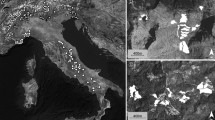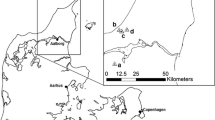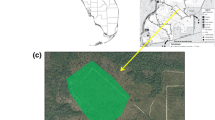Abstract
The occurrence pattern of the marsh fritillary was studied within a patch network on the Baltic island Öland, Sweden. Presence/absence was established for potentially suitable habitat patches (n = 158) on calcareous moist grassland and analyzed in a multiple logistic regression model where patch area, patch isolation and nine habitat quality variables were included as explanatory variables. Larval food plant density was positively, and patch isolation negatively, correlated to the presence of Euphydryas aurinia. Area did not contribute to the explanation of the occurrence pattern. Significant interactions between larval food plant density times patch isolation, and larval food plant density times vegetation height, show that with low food plant density the butterfly primarily occurs in patches with a vegetation height of 4–10 cm, within a distance of 250 m from nearest occupied patch. In patches with a high food plant density the butterfly occurs in patches where the vegetation height is higher, 4–16 cm, and the distance to nearest occupied patch can be longer, up to 1.4 km. This study supports earlier findings in other regions, suggesting that a network of adjacent patches with a high food plant density and a vegetation height within the preferred threshold, despite their size, is an apparent conservation goal.


Similar content being viewed by others
References
Anthes N, Fartmann T, Hermann G, Kaule G (2003) Combining larval habitat quality and metapopulation structure- the key for successful management of pre-alpine Euphydryas aurinia colonies. J Ins Conserv 7:175–185
Bulman CR (2001) Conservation biology of the marsh fritillary butterfly Euphydryas aurinia. Ph.D. University of Leeds
Council Directive 92/43/EEC of 21 May 1992 on the conservation of natural habitats and of wild fauna and flora (the Habitats Directive). EGT L 206
Dennis RLH, Eales HT (1997) Patch occupancy in Coenonympha tullia (Lepidoptera:Satyridae): Habitat quality matters as much as patch size and isolation. J Ins Conserv 1:167–176
Dennis RLH, Shreeve TG, Van Dyck H (2006) Habitats and resources: the need for a resource-based definition to conserve butterflies. Biodiv Conserv 15:1943–1966
Douwes P (1976) An area census method for estimating butterfly numbers. J Res Lep 15:146–152
Ekstam U (ed) and Forshed N (ill.) (1996) Äldre fodermarker. Naturvårdsverkets Förlag, Stockholm
Eliasson CU (2006) Åtgärdsprogram för väddnätfjäril Euphydryas aurinia. Naturvårdsverket, Stockholm
Eliasson CU, Shaw MS (2003) Prolonged life cycles, oviposition sites, foodplants and Cotesia parasitoids of Melitaeini butterflies in Sweden. Oedippus 21:1–52
ESRI (2000) ArcView GIS 3.2.a. ESRI, Redlands
Forslund M (ed) (2001) Natur och kultur på Öland. Administration Board of Kalmar County
Fowles AP (2005) Habitat quality mapping for marsh fritillary populations. Scientific report 05/5/1. Countryside council for Wales
Fowles AP, Smith RG (2006) Mapping the habitat quality of patch networks for the marsh fritillary Euphydryas aurinia (Rottemburg, 1775) (Lepidoptera, Nymphalidae) in Wales. J Ins Conserv 10:161–177
Gärdenfors U (eds) (2005) The 2005 Red List of Swedish Species. Artdatabanken, SLU Uppsala
Hanski I (2000) Extinction debt and species credit in boreal forests: Modeling the consequences of different approaches to biodiversity conservation. Ann Zool Fenn 37:271–280
Hobson R, Bourn N, Warren M (2002) Conserving the marsh fritillary in Britain. Br Wildlife 13:404–411
Hosmer DW, Lemeshov S (2000) Applied logistic regression. Wiley, New York
Hula V, Konvicka M, Pavlicko A, Fric Z (2004) Marsh fritillary (Euphydryas aurinia) in the Czech Republic: monitoring, metapopulation structure and conservation of an endangered butterfly. Entom Fenn 15:231–241
Konvicka M, Hula V, Fric Z (2003) Habitat of pre-diapausing larvae of the endangered butterfly Euphydryas aurinia (Lepidoptera: Nymphalidae): What can be learned from vegetation composition and architecture? Eur J Entom 100:313–322
Lewis OT, Hurford C (1997) Assessing the status of the marsh fritillary butterfly (Euphydryas aurinia): an example from Glamorgan, UK. J Ins Conserv 1:159–166
Metria (2000) Vegetation map of Öland. Administration Board of Kalmar County
Naturvårdsverket (2003) Dagaktiva fjärilar. www.naturvardsverket.se/dokument/mo/hbmo/del3/skog/dagfj.pdf. Version 1:1
Norberg U, Enfjäll K, Leimar O (2002) Habitat exploration in butterflies- an outdoor cage experiment. Evol Ecol 16:1–14
Porter K (1981) The population dynamics of small populations of the butterfly Euphydryas aurinia. Ph.D. Oxford University
Porter K (1982) Basking behaviour in larvae of the butterfly Euphydryas aurinia. Oikos 38:308–312
Ravenscroft NOM, Gaywood MJ (1996) The status and habitat of the marsh fritillary butterfly in western Scotland. Research, survey and monitoring report 21. Scottish natural heritage
Saarinen K, Jantunen J, Valtonen A (2005) Resumed forest grazing restored a population of Euphydryas aurinia (Lepidoptera: Nymphalidae) in SE Finland. Eur J Entom 102:683–690
Schoener TW, Spiller DA (1987) High population persistence in a system with high turnover. Nature 330:474–477
Schtickzelle N, Choutt J, Goffart P, Fichefet V, Baguette M (2005) Metapopulation dynamics and conservation of the marsh fritillary butterfly: population viability analysis and management options for a critically endangered species in western Europe. Biol Conserv 126:569–581
StatSoft (2005) STATISTICA version 7.1. StatSoft Inc, Tulsa
Stewart KEJ, Bourn NAD, Thomas JA (2001) An evaluation of three quick methods commonly used to assess sward height in ecology. J Appl Ecol 38:1148–1154
Thomas CD, Thomas JA, Warren MS (1992) Distribution of occupied and vacant butterfly habitats in fragmented landscapes. Oecologia 92:563–567
Thomas JA (1983) A quick method for estimating butterfly numbers during surveys. Biol Conserv 27:195–211
Thomas JA, Bourn NAD, Clarke RT, Stewart KE, Simcox DJ, Pearman GS, Curtis R, Goodger B (2001) The quality and isolation of habitat patches both determine where butterflies persist in fragmented landscapes. Proc Roy Soc Lond ser B 268:1791–1796
Tilman D, May RM, Lehman CL, Nowak MA (1994) Habitat destruction and the extinction debt. Nature 371:65–66
van Swaay CAM, Warren MS (1999) Red data book of European butterflies (Rhopalocera). Nature and Environment, No. 99. Council of Europe, Strasbourg
Wahlberg N, Klemetti T, Hanski I (2002a) Dynamic populations in a dynamic landscape: the metapopulation structure of the marsh fritillary butterfly. Ecography 25:224–232
Wahlberg N, Klemetti T, Selonen V, Hanski I (2002b) Metapopulation structure and movements in five species of checkerspot butterflies. Oecologia 130:33–43
Warren MS (1994) The UK status and suspected metapopulation structure of a threatened European butterfly, the marsh fritillary Euphydryas aurinia. Biol Conserv 67:239–249
Woodman J, Fowles AP (2002) Action for the marsh fritillary in Wales. Natural Science Report 02/5/03. Countryside council for Wales
Woolley D (2001) Rhos Llawer Cwrt NNR: Marsh fritillary data 2000. Countryside Council for Wales
Acknowledgements
The authors acknowledge Markus Forslund and Helena Lager, Administration Board of Kalmar County, for providing vegetation maps and support, and Mark Shaw and Sarah Martin for examination of the braconid wasps, and two anonymous referees that provided many helpful suggestions.
Author information
Authors and Affiliations
Corresponding author
Rights and permissions
About this article
Cite this article
Betzholtz, PE., Ehrig, A., Lindeborg, M. et al. Food plant density, patch isolation and vegetation height determine occurrence in a Swedish metapopulation of the marsh fritillary Euphydryas aurinia (Rottemburg, 1775) (Lepidoptera, Nymphalidae). J Insect Conserv 11, 343–350 (2007). https://doi.org/10.1007/s10841-006-9048-3
Received:
Accepted:
Published:
Issue Date:
DOI: https://doi.org/10.1007/s10841-006-9048-3




